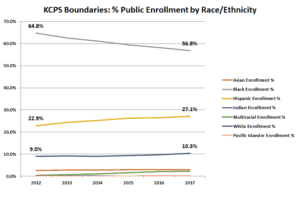Indianapolis Public Schools are “blurring the lines” between traditional public schools and charter schools, re-shaping how public education is organized and governed in Indy.
Last week I had the opportunity to attend an education conference in Indianapolis, Indiana.
Organized by the Progressive Policy Institute in partnership with The Mind Trust and Education Cities, the conference was about changes underway in the Indianapolis Public School System (IPS) that are “blurring the lines” between traditional public schools and charter schools and are re-shaping how public education is organized and governed in Indy.
It’s a compelling story. IPS is embracing the idea of school autonomy in a traditional district context, using it as a lever for turning around failing schools, starting new schools, and for taking successful IPS schools to the next level. It’s capitalizing on its competitive advantage as a school district, and as the largest operator of schools and school buildings in Indianapolis, to bring this idea of school autonomy – coupled with rigorous accountability – to scale across the IPS system.
By doing this IPS has put itself back in the center of education reform in Indianapolis. Instead of trying to work around IPS, education organizations in Indianapolis – including some very well-established and successful Indy charter schools – are now actively pursuing partnerships with the district.
Participating schools and school leaders get access to IPS buildings and valuable support services – like special education and transportation – at no cost. This frees up time and dollars to focus on the school’s mission, rather than on operations.
In exchange, IPS gets to set the conditions of these partnerships. Because IPS owns the school facilities, it can direct operators to parts of the district that actually need new school options.
Schools that partner with IPS must participate in the district’s unified enrollment system.
And if they take over a failing neighborhood school, they have to commit to serving all of the students in the neighborhood, not just Kindergarten and first grade (this slow-start model is very common in school start-ups, for good reason – it works. But in a neighborhood context, it can be pretty disquieting. We visited a school and saw how this more inclusive start-up model worked in practice).
I know – this all sounds like crazy talk. But it’s not.
All of what’s happening in Indy is actually based on two simple ideas: 1) that it’s the educators in schools, working closest with students, who are best-positioned to make decisions in students’ best interests. That is, school leaders should actually be able to lead. And, 2) that “the district” can actually be set up to facilitate this mission-driven work, rather than hinder it.
Consensus around these two core ideas – fueled by a belief that the system, as currently set up, was not working – ultimately led to the passage of state legislation in 2014 that “blurred the lines” and created IPS Innovation Network Schools, now in their first year of operation in Indianapolis.
I’ll be writing more about these innovation schools – what they are, how they work, and who’s involved – in my next few posts.
In the meantime, though, I think what’s most heartening about what’s happening in Indy – and what I was most excited to come home and share – is that there’s a city, very similar to Kansas City in many ways, that’s trying to forge a sustainable middle path between an all charter and all-traditional district – a path, I’m convinced, that’s ultimately much better for students and families. And it’s Indianapolis Public Schools that’s leading the charge.
 Click here to read the full story.
Click here to read the full story.






